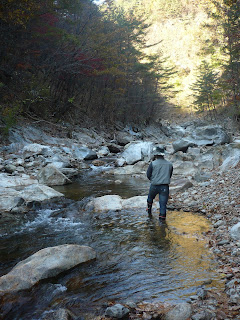
The acrid smell of dried cod unceremoniously stung my nostrils as I stepped out of the train station into the heart of Gangwon Province, South Korea. As usual, the ancients who somehow managed to squeak out a meager existence in this speck of a village forgotten by youth were sitting outside their one-room cottages fancying the falling sun through diminutive eyes that viewed my passing with wise indifference. My most polite hello—“Are you in peace?”—accompanied an awkward bow, and I hurried on.
Just past the valley entrance, I arrived at the homestay and happily discovered that the now full grown puppy’s future was not to be found in a simmering pot of stew. Inside, the Halmoni, a lively old matriarch who had claimed this valley as her home for more than 70 years, seemed happy to see me and jokingly asked if I might bring her a fish this time. As she led me to the room closest to the creek, I told her my usual response, “Maybe this time, Grandmother. Maybe this time.”
Within minutes, water that had taken its first breath at the cave entrance near the top of the valley flowed past my legs. The sounds of murmuring riffles above and below me spoke of something more than soothing. I began to probe the pockets and currents of small pools with my minuscule dry fly.
Slightly upstream, two currents mingled matrimonially to create a soft seam of white. Intermittent dimples among the foam indicated sancheoneo (literally “mountain stream fish”), or cherry trout, sucking hapless midges from the meniscus. My first two attempts to hit the seam failed, but my size 20 A.K. Emerger smoothly spliced it on the third. A tiny head appeared; the fly vanished. I lifted the rod and felt its serendipitous surge: the cherry’s power proved greater than its size; and moments later, a slow current moved over the small, wild trout as I admired the fish in my hand. Its colors were mesmerizing: oversized blue parr marks punctuated a painter’s streak of rose-colored red; silver, cream, and gold scales were splattered with spots the size and color of pupils in low light.
After watching the fish swim strongly into the current, I continued upstream with high spirits.

When I turned the corner of the following bend, the sight of the dam shattered the elation of my catch. Crudely consisting of a thick sheet of black plastic held together by enough rocks to divert the creek into a make-shift box made from chicken wire and plywood, the dam’s purpose was apparent. I first checked the trap for any fish unfortunate enough to have been caught; there were none. Then, after scanning the horizon for suspicious eyes that might disagree with my actions, I began disassembling the dam. Each rock was a precarious puzzle piece that, if positioned properly, would again allow the natural, free flow of water and passage of cherry trout.
Walking back to the homestay, I contemplated the precious jewel of a fish I had held in my hand and the implications of the dam. A hawk soaring above seemed to hear my thoughts and gave out a cry that echoed against the steep canyon walls
Later that night, I made a modest bed on the floor of my room. Despite the cold, I opened the window facing the creek just enough to hear the soft, low hum of the water below, knowing with a deep sense of contentment that its words would lull me to sleep. Finally, as thoughts of beloved cherries rising to my dry fly competed with my drowsiness, I slowly drifted towards dreams downstream.





